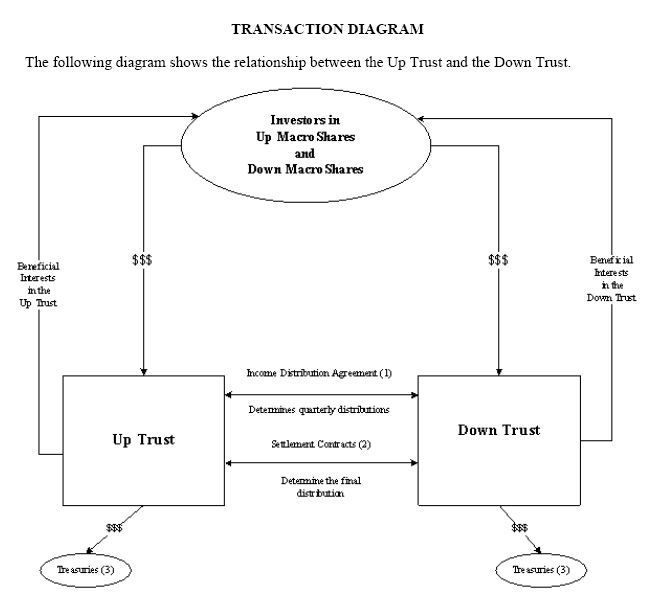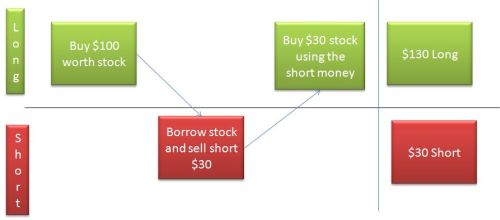Macroshares has come up with a 3X leveraged ETP, for the housing market, which is similar to the one it had for Oil (UOY) (the one that terminated early).
It is meant to give you a way to invest in housing, but it will not go out and buy any real estate, nor will it buy stocks of companies that invest in or are related to real estate, and it won’t even get into any future contracts.
So how will Macroshares Metro ETP let you own housing?
Well, this is not the usual daily leveraged ETF or inverse ETF, and works differently from most ETFs, and is an ETP not an ETF either.
Here is how it works.
Macroshares has issued a pair of funds – one Up and one Down. Both will track an underlying reference index and if one is up, the other will be down and vice – versa.
At the end of a given period, if the reference index rose, then assets worth 3 times the movement will be transferred from the Down index (DMM) to the Up index (UMM). The ETP will only hold Treasuries and Repos on Treasuries as assets. To me this is like taking money from one pocket and putting it into another, while charging a fee for it.
Here is a graphical representation taken from the prospectus:

This is a complex financial product and I really can’t think of any use for this type of security for most investors. So, here are some aspects about Macroshares Metro, which will help you decide, if this is meant for you or not.
You can lose all your money
The good news is that you can’t lose more money than you have invested in this ETP; the bad news is that you can lose all of it.
If the S&P / Case Shiller Composite – 10 Home Price Index falls below 108.11, you will lose all your investment in the Macroshares Housing Up Shares. If the index rises above 216.23, you will lose all your money in the Macroshares Housing Down Shares.
Your upside is capped in UMM and DMM
Since, both the Up and Down shares are issued in pairs, one’s profit is another’s loss, this also means that your gains are capped.
So, keep in mind that when you are buying Macroshares Major Housing Up or Down Shares — you are buying something that can go down to zero, but has a cap on how much it can rise.
Reference Index of UMM and DMM
The reference Index of the MacroShares Major Metro Housing Up and Down ETPs is the S&P / Case Shiller Composite – 10 Home Price Index. The S&P/Case-Shiller Home Price Indices only measure changes in the market values of pre-existing single-family detached houses, though both homes that serve as primary residences and homes that are considered vacation or investment properties are included in the calculation of the indices.
Even though there is a reference index, the price of the Up and Down ETPs will be determined by the demand and supply in the market and there will be no arbitrage or other pressure
Macroshares Major Metro Housing does not move in pairs
Even though UMM and DMM are designed to be pairs and move in tandem with each other, in reality they don’t move exactly like that. Each trust will make quarterly payments to the other according to the way the Case Shiller index behaved.
As far as assets are concerned, the revenue generating assets are just the US Treasuries that will accrue interest to the Macroshares Housing ETP.
There are several other factors that affect the market prices other than the reference index and this same phenomenon was seen in the MacroShares Oil Down and Up Tradeable Shares also. Their value differed from the underlying value of the shares and those got terminated early.
The ETPs have a termination date of Nov 2014, and it is only then that the value of the funds will be reconciled with the value of the underlying asset. Before then the price will move like stock prices do on investor expectation.
UMM and DMM are not the same as buying or selling a house
This is not the same as buying a house or hedging against a house because of several reasons. One is that it has 3X leverage so the gains and losses are magnified.
Two, this really can go to zero, while your house will rarely ever go to zero. The upside is capped in DMM or UMM, while the upside is not capped in a house.
Factors other than the reference index will impact the price of your Macroshares Up or Down unit.
The annual fee and operating expense that Macroshares charge might eat up the assets of the fund itself.
Termination Date of UMM and DMM
MacroShares has set November, 25 2014 as the termination date for the UMM ETP. So, if the fund lasts that long, it will get terminated on that day and unit holders will be paid according to the index value. There are several reasons because of which UMM or DMM may terminate before 2014, and the most prominent among them is the underlying index going above or below a certain value.
For three (3) consecutive monthly index publication days, the S&P/Case-Shiller Composite-10 Home Price Index level is equal to or below 108.11 or equal to or above 216.23. At and above an index level of 216.23, the Up Trust would be entitled to 100.00% of the Down Trust’s assets under the settlement contracts and at and below an index level of 108.11, the Down Trust would be entitled to 100% of the Up Trust’s assets under the settlement contracts.
Expense Ratio of MacroShares Housing Up and Down Shares
The ETP charges a rather high expense ratio of 1.25% of assets. The fund will also need to pay an additional fixed amount that is estimated at $600,000 per year.
If the treasury income of UMM or DMM doesn’t cover the expenses, then they will be recovered from the assets of the fund.
Brief Summary
This post is much longer than my usual posts, so I’ll give you a brief summary here:
- The MacroShares Metro Housing ETP is issued in Up and Down pairs.
- It doesn’t move exactly in tandem with each other.
- This is not a hedge against home prices
- Your fund can go to zero
- Your upside is capped.


